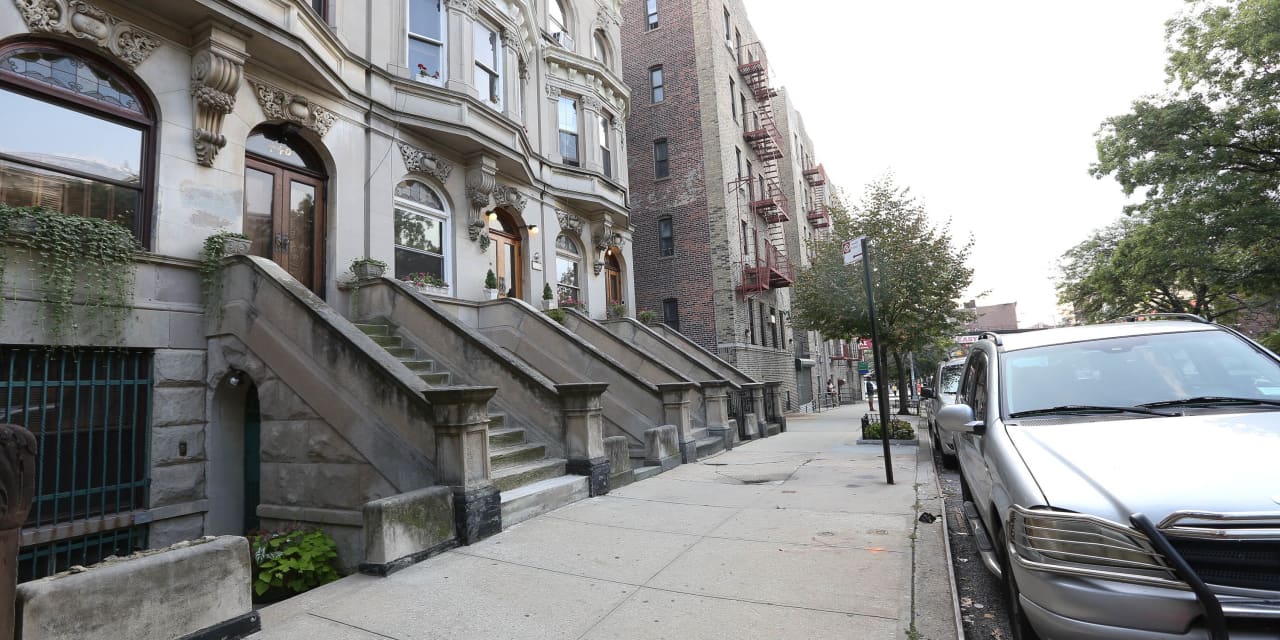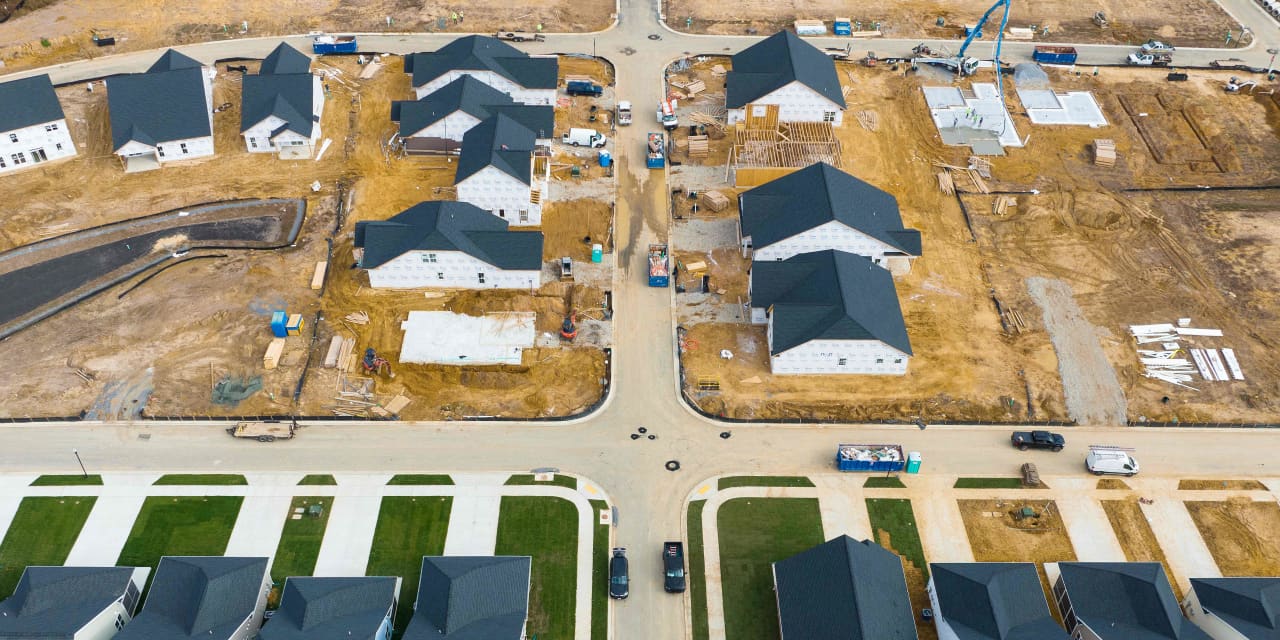New York Community Bancorp Inc. has been looking to shed problem commercial real estate from its books after last week reporting a surprising $185 million loss relating to a pair of loans as part of its fourth-quarter earnings results.
The lender has offered investors a chance to bid on a $22.4 million mortgage backed by three five-story walk-up apartment buildings in Washington Heights, a neighborhood in northern Manhattan, according to details of the offering viewed by MarketWatch.
The debt backs mostly rent-regulated apartments and affiliated mixed-use space. The mortgage matured in early January, with the full amount of the debt now due, plus interest at a 20% default rate, according to the offering.
Other landlords in the neighborhood who are subject to New York City’s rent-regulation laws, which were strengthened in 2019, have seen property values tumble by an estimated 50%, according to Bloomberg News.
New York Community Bancorp
NYCB
didn’t respond to requests for comment for this article.
Efforts by the bank to tackle its exposure to problem real-estate loans come as its stock has dropped by more than 60% so far this year.
The lender has a large exposure to rent-regulated multifamily properties in New York City, about a $1.8 billion office-building exposure in the city and about $250 million to $300 million in maturities in the next few years, according to Deutsche Bank researchers.
Pressures facing the bank are reigniting fears about regional banks and their commercial real-estate exposure. Treasury Secretary Janet Yellen told lawmakers on Tuesday that she was concerned about U.S. commercial real estate, saying that some institutions could be “quite stressed,” while also saying the challenge looks manageable.
Landlords have been reeling from slumping property prices and higher borrowing costs since the Federal Reserve in 2022 began dramatically raising interest rates to quell high inflation.
Many regional banks have responded by trying to quietly shed exposure to problem commercial real estate. That activity has picked up since the collapse of Silicon Valley Bank and Signature Bank last March and JPMorgan Chase & Co.’s
JPM
takeover of First Republic Bank, which deeply unsettled markets.
Late Tuesday, Moody’s Investors Service downgraded New York Community Bancorp’s credit by two notches into speculative-grade or “junk” status.
“We took decisive actions to fortify our balance sheet and strengthen our risk management processes during the fourth quarter,” Thomas Cangemi, New York Community Bancorp’s president and chief executive officer, said in a statement following the downgrade.
Cangemi also said that the bank has ample liquidity and has been growing its deposits and that the downgrade wasn’t expected to have a material impact on the lender’s contractual arrangements.
Sales of assets, even at a discount, can sometimes help banks get ahead of greater problems facing the industry, loan buyers said. But they also expect commercial-real-estate lenders to endure a challenging few years, especially as a wall of old debt comes due at a time of higher interest rates.
See: ‘No one is throwing good money after bad.’ Why 2024 looks like trouble for commercial real estate.
New home sales rose 4% in 2023—even as high mortgage rates and low supply buffeted the broader housing market.
New homes in December were sold at a seasonally adjusted annual rate of 664,000, up 8% from November’s upwardly revised rate of 615,000, according to Census data released Thursday. Economists had expected sales at a seasonally adjusted annual rate of 645,000, according to FactSet.
The…
New home sales rose 4% in 2023—even as high mortgage rates and low supply buffeted the broader housing market.
New homes in December were sold at a seasonally adjusted annual rate of 664,000, up 8% from November’s upwardly revised rate of 615,000, according to Census data released Thursday. Economists had expected sales at a seasonally adjusted annual rate of 645,000, according to FactSet.
The data caps out an unusual year for the housing market. Sales of previously owned homes, which make up the bulk of all house sales, fell 19% to 4.09 million, the National Association of Realtors said earlier this month—the lowest annual total in nearly 30 years. Sales of previously owned homes were hampered by rising mortgage rates and relatively low supply.
New home sales, meanwhile, expanded: there were 668,000 contracts signed to purchase new homes in 2023, the Census data show, up 4.2% from 2022’s levels. It was the first year-over-year expansion in new home sales since 2020, when they jumped as mortgage rates fell to historic lows and newly remote workers sought more space.
It’s not that builders were immune to broader housing market headwinds. Rather, companies were able to sell homes by offering incentives such as mortgage rate buydowns. Of the builders surveyed in January by the National Association of Home Builders, 62% offered sales incentives, a common theme from 2023 that has continued into the new year. While offering incentives can boost sales, it’s also a drag on profit margins.
Advertisement – Scroll to Continue
The picture for housing looks brighter in 2024.
said in its latest forecast that it expects mortgage rates to fall below 6% by the end of the year.
Write to Shaina Mishkin at shaina.mishkin@dowjones.com
Published: Jan. 8, 2024 at 2:19 a.m. ET
By Joe Hoppe
Home REIT said it collected 12% of the rent invoiced for the month of December, after investment manager AEW UK Investment Management made further progress obtaining control over its assets from non-performing tenants.
The real-estate investment trust said Monday that auction sales have continued, having agreed sales on a further…
By Joe Hoppe
Home REIT said it collected 12% of the rent invoiced for the month of December, after investment manager AEW UK Investment Management made further progress obtaining control over its assets from non-performing tenants.
The real-estate investment trust said Monday that auction sales have continued, having agreed sales on a further 81 properties for 16.4 million pounds ($20.9 million) in December, with completion expected in January.
Total borrowings were reduced to GBP172.7 million, from GBP198.3 million a month prior. The company’s cash balances at Dec. 31 stood at GBP15.8 million, of which GBP5.4 million is unrestricted.
Home REIT had said in early September that AEW engaged with all of its tenants and carried out a number of actions to begin inspecting and valuing its portfolio. It said the manager was focused on stabilizing Home REIT’s property portfolio and financial condition, and planned to maximize income and capital returns.
Write to Joe Hoppe at joseph.hoppe@wsj.com




